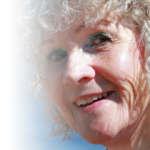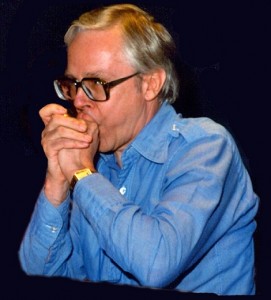 A red canoe rests along the shoreline, reminiscent of northern Ontario lakes, the mist rising in the distance. I almost can hear the water lapping against the rocks and logs, and envision the canoe dipping up and down in the gentle waves.
A red canoe rests along the shoreline, reminiscent of northern Ontario lakes, the mist rising in the distance. I almost can hear the water lapping against the rocks and logs, and envision the canoe dipping up and down in the gentle waves.
Whenever this image pops up in a Windows screensaver nature series, I think of my father and some of his happiest times. These include discovering the bush and the relaxed fun of fishing, in the company of his friend Donald, and other times fishing with my mother’s brother Lloyd. In those days of my young childhood, such northern Ontario holidays really were a world apart from the domesticity of suburban life and, for my Dad, an interlude from the daily grind as sole family breadwinner.
Getting away to cottage country truly was a rustic, wilderness experience. Cabins had woodstoves for heat, kerosene lamps for light, no indoor plumbing and the need of a flashlight or lamp at night to get to the outhouse. That was part of the adventure, to seek simplicity, peace and quiet, in a relaxing environment that called upon a person’s resourcefulness and creativity in ways that also fed one’s inner life.
Indeed, the fond memories held by my father are evident in the beautifully crafted paintings that he created later in life, evoking scenes from those specific trips as well as other imaginary Canadian northern wilderness images. My father’s body of art work is emblematic of two types of healing – the act of painting and the experiential memory of the world of Nature.
Dad had wanted to be a professional artist, perhaps work as a commercial illustrator. He took special art classes during his high school years. But, his father frowned upon both his son’s artistic and athletic aspirations. For Dad also enjoyed lacrosse. In those days, lacrosse was a national Canadian sport competing with hockey in popularity.
The pressure to pursue an economically secure livelihood, consequently, trumped my father’s dreams, a fate similarly experienced by many young adults of his generation, in the years between the Great Depression and the Second World War. Dad, instead, entered the business world, while also given time away by his employer to be in the armed forces, earning accolades as a Warrant Officer during WWII.
Dad, afterwards, returned to the business world, working his way up to an executive level. He travelled internationally to Europe, Hong Kong, Japan, and to major cities in the United States, on various trips each year throughout my childhood. Mom and I missed him terribly during these absences.
Nor were such travels glamorous or fun for him, as I learned much later in life. Aside from brief bouts of sightseeing and occasional invitations to the homes of business associates, Dad confessed to me his own loneliness, sitting night after night in hotel rooms doing long, tedious hours of paper work, added to each day of business negotiations.
Then, the unimaginable happened, when Dad perhaps was only in his mid-50s. That period was during my own marital breakdown, so it all is a blur of black memories. Dad’s position was given to a younger man, in fact, his protege, yet happened unexpectedly, several years before my father’s anticipated retirement.
The loss to his dignity and pride, after earning good profits consistently for the company through many years, almost killed him. His entire identity was intertwined with a lifetime of diligent work dedicated to one corporation. That loyalty was common in my father’s generation, which is why the early retirements foisted upon a number of executives during that same period, by several companies, was particularly brutal for those men and women.
I reflect on the treatment of working people in our society, then and now, as one of the themes of this remembrance some days following the celebration of Father’s Day. It is held on the third Sunday of June, in Canada, the United States and the United Kingdom.
Another theme here is my profound gratitude in experiencing a father’s love and being able to reciprocate, especially through his dark years, choosing to walk beside him as a supportive guide into the light again.
Reflect on the fact that, despite the specific characteristics of this moment’s economic woes and widespread unemployment, it is not the first time in modern North American society that large numbers of people have experienced hardships, through no employment, under employment, or losing jobs, and confronted with figuring out how to move forward. Yet, when does the toll on a person’s self-respect and soul ever get addressed?
The issue that requires both the mind and the heart to ponder is, what are the ways in which we can offer at least moral and emotional support, if not financial support, to the people hurting around us, whether family members, neighbours, (former) colleagues, friends, as well as those who are systemically disenfranchised? This question deserves much more attention, which one or more future blogs will revisit.
My father almost self-destructed. He came close to losing his will to live, given the ripping away of purpose and contribution in the wider world and no longer feeling needed in it. Again, loyalty to one company through a lifetime of work was the norm in his era.
I recalled Dad’s youthful love of drawing and painting, and brought him arm loads of art supplies, books about artists, brochures of trips that we could take to a northern cabin, and initiated visits together to the Art Gallery of Ontario – anything to ignite his will to live by kick starting his artistic drive again. It worked.
He did not take the outer world trips north. Dad, more importantly, chose the inner world journey. Although his earliest art as a youth showed great promise, his later paintings evoke a much deeper and more expansive knowing. My father drew a path way back into a land in which life is worth living again.
What I provided was the love and the belief in him that his life had meaning. Yet, ultimately, the decision to stay alive resides within the heart and the soul of the person who is wounded.
I truly believe that each of us has come into this world with particular purposes, for our soul to grow. Discovering what our spiritual lessons will be, and how we respond, is the essence of our life’s journey.
My father, more than once, expressed his gratitude that I came into his life, in the years following my adoption up to the end of his life. Indeed, his final years and, more poignantly, his final days, are a story for another time. To sum up the latter, he expressed his appreciation that my caregiving enabled him to stay in his own home rather than be institutionalized. I am so glad that I could honour him in that way.
Whether looking at the soul relationship between us, spiritually or psychologically, Dad and I gave each other significant loving comfort. His gift to me was an authentic unconditional love, throughout the time he was here, regardless of the occasions when we could not agree with, or understand, each other.
To close this remembrance of a loving father, I will share a sweet story about my adoption. The complementary elements of this story can be found in the May 2012 blog about my two mothers.
Interestingly, both my mothers had the same doctor. He suggested to my adoptive parents, who just had lost their third baby at birth, that a baby down the hall was available for adoption. As my father told it, he had lectured to his wife, both of them terribly distraught, that they must not make a rash decision when a nurse first presented me.
Well, as the story goes, any such rational thinking disappeared when my Dad laid eyes on me; for I apparently looked at him directly and smiled. “We’ll take her,” was his immediate response. He would joke with me, in recounting this tale, his later realization that perhaps the wee lass had farted, which prompted my smile.
A final, poignant, note is, when I meticulously searched through all of my late parents’ belongings in the family home, I found something sacred in one of my father’s dresser drawers. Although he loved me dearly, Dad never forgot the three babies that he and his wife, to whom he remained devoted throughout their life together, had lost.
Three tiny envelopes were tucked away in a drawer, the contents identifying their respective burials. I kept them, safe-guarded among other special belongings of my parents.
The generosity of giving love and the grace to receive love, in its various life-affirming forms, are the highest qualities that I believe we are here on Earth to learn, experience and bestow, as well as respect for the sacredness of life.

